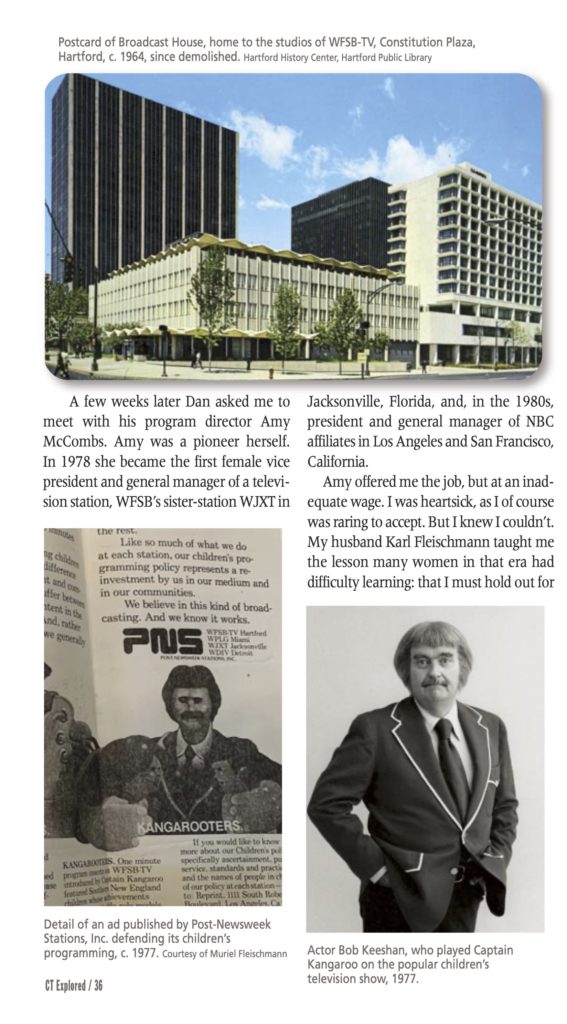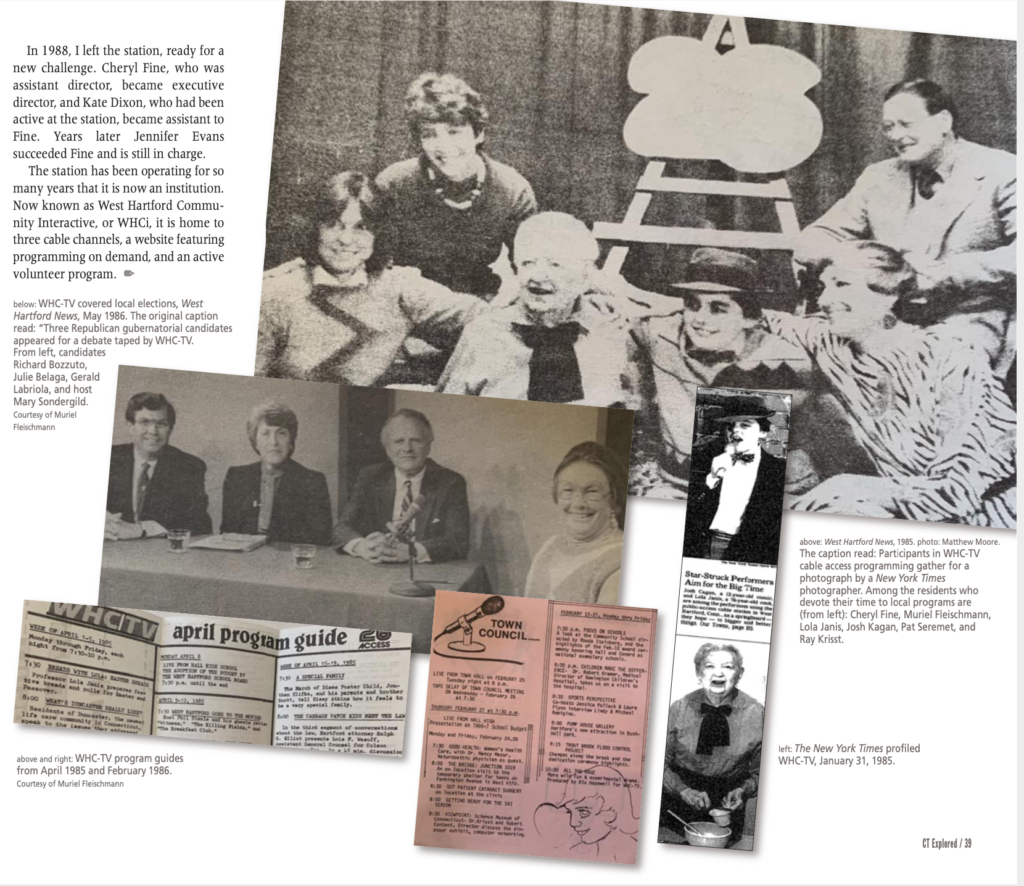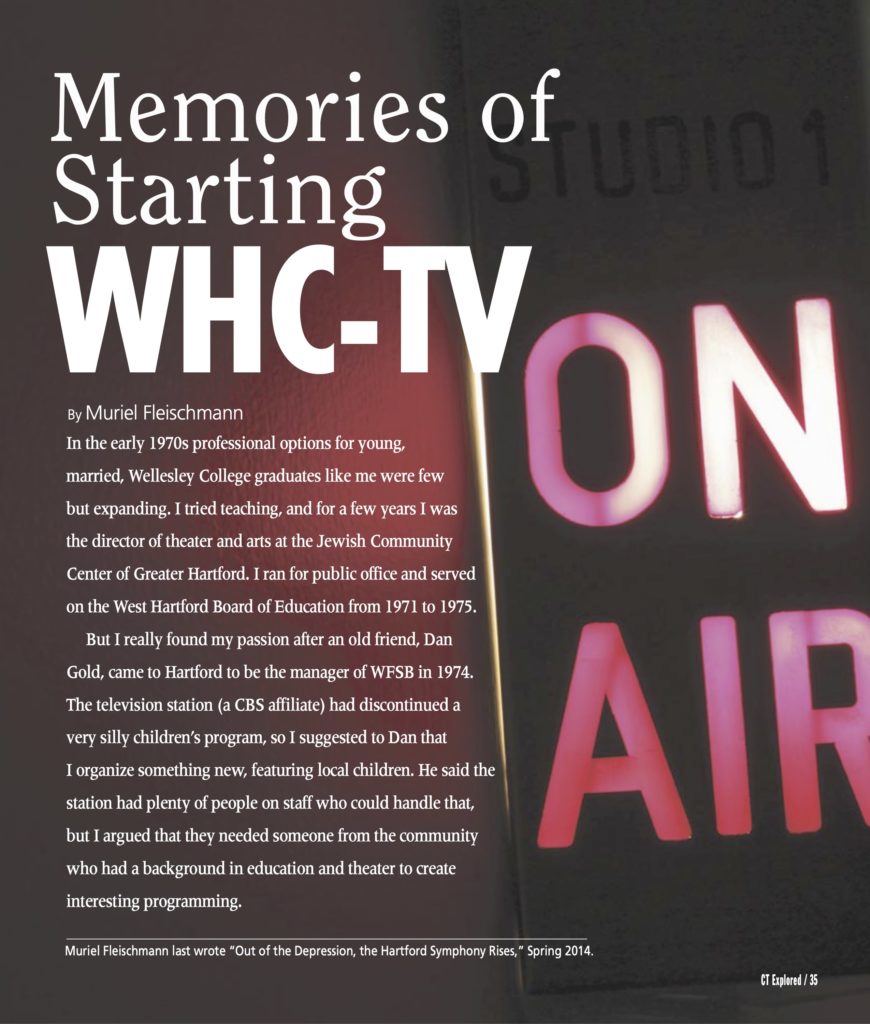(c) Connecticut Explored Inc. Winter 2020-2021
Subscribe/Buy the Issue!
In the early 1970s professional options for young, married, Wellesley College graduates were few. I tried teaching, and for a few years I was the director of theater and arts at the Jewish Community Center of Greater Hartford. I ran for public office and served on the West Hartford Board of Education from 1971 to 1975.
But I really found my passion after an old friend, Dan Gold, came to Hartford to be the manager of WFSB in 1974. The television station (a CBS affiliate) had discontinued a very silly children’s program, so I suggested to Dan that I organize something new, featuring local children. He said the station had plenty of people on staff who could handle that, but I argued that they needed someone from the community who had a background in education and theater to create interesting programming.
A few weeks later Dan asked me to meet with his program director Amy McCombs. Amy was a bit of pioneer herself. In 1978 she became the first female vice president and general manager of a television station, WFSB’s sister-station WJXT in Jacksonville, Florida, and, in the 1980s, president and general manager of NBC affiliates in Los Angeles and San Francisco, California.
Amy offered me the job, but at an inadequate wage. I was heartsick, as I of course was raring to accept. But I knew I couldn’t. My husband Karl Fleischmann taught me the lesson many women in that era had difficulty learning: that I must hold out for more money. And it worked. Amy offered more money and even threw in an assistant.
The program was to be called “Kangarooters,” and it was a so-called “doughnut.” Bob Keeshan, the principal in the nationally syndicated show Captain Kangaroo, would come to Hartford and record an opening and closing, and I would insert a three-minute segment. The segment I produced would, for example, be an on-site interview in which local children would talk to host Hilton Kaderli (later a longtime weatherman for the station), or a child would interview another child.

(top) Postcard of Broadcast House, home to the studios of WFSB-TV, Constitution Plaza, Hartford, c. 1964, since demolished. Hartford History Center, Hartford Public Library. (bottom left) Detail of an ad published by Post-Newsweek Stations, Inc. defending its children’s programming, c. 1977. Courtesy of Muriel Fleischmann. (bottom right) Actor Bob Keeshan, who played Captain Kangaroo on the popular children’s television show, 1977.
One of the funniest segments, one that came out of my demo tape, involved my youngest son Martin, then six years old, interviewing his friend Richard Maenza, who owned a large snake. As Richard calmly talked, the snake wrapped around his head and neck while Martin gasped in dismay. It, along with other memorable pieces, was submitted on a show tape that won the regional Emmy in Boston in 1977.
In late 1978 with my father’s death imminent, I took a year off to be available to him before thinking of my future. During this time I drove to Plainville to meet the Rasmussen brothers, who were sitting on boxes in a bare room and planning their new TV sports network. They called it ESPN. The brothers told me that they had secured a transponder spot on a satellite for $100,000 in order to start this project. I was interested in what they had to say, as I had had in mind a children’s station or a food station and thought a woman’s network would be a terrific idea.
I went home and told my relatives that I needed to raise the money to get into cable television. They laughed at the idea that a woman in her 30s with three little kids would consider such a thing. I gave up the thought. I sometimes reflect that if I had been a young man searching for a career I might well have been able to raise the money and, like the Rasmussens, pioneered in cable television. Today, a woman college graduate with a provocative idea could plausibly raise money. But in 1978 it seemed humorous to my family and impossible to me.
At this very time, West Hartford Mayor Nan Streeter was investigating the likelihood that a cable company would lay and run cable in our area. She formed a committee and began to investigate.
I didn’t know of Streeter’s investigation at the time, but I was aware that former Hartford school superintendent Edythe Gaines, a commissioner of the state’s Department of Public Utility Control, was vetting Times Mirror to be the cable provider for community access TV in Hartford, and I went to listen to the public hearings. I learned that the provider was required to offer a local cable outlet for the community, but that Times Mirror was trying to renege on this requirement. I wrote a letter to the analogous Montgomery County, Maryland officers who were also vetting Times Mirror as their provider; I sent a copy to the Times Mirror people here. In my letter I revealed that they were not fulfilling their Connecticut obligations. Shortly thereafter, a studio on Shield Street in West Hartford was built and outfitted by Times Mirror for use by Hartford, West Hartford, and other area towns.
West Hartford soon established a local cable station, WHC-TV. A board of directors headed by Nan Streeter was established, the West Hartford Public Library provided a basement room for the station to use, and we started to produce materials. When the station interviewed for an executive director, they hired me part time. It was a dream come true.
I hired My Nguyen, a Conard High School senior who had emigrated with his family from Vietnam, to air pre-recorded tapes from 7 to 10 p.m. each night. One night, as snow fell, I worried about Nguyen’s biking to the library. At our home for dinner one night, he reassured me that his evening bike rides through the streets of West Hartford were nothing compared to the risks his family had run in escaping from Vietnam. He went to Brown University after finishing at Conard.
With a portable field camera and some editing equipment, we started some local programming. Once again, my first efforts involved my family. In a very cold vineyard I filmed Karl discussing local winemaking. His teeth were chattering. He suggested that next time it would be better to talk indoors. This led to a studio show in which he and fellow West Hartfordites Fred Werner and wine neophyte Valerie Smith hosted a show called the West Hartford Wine Party. (We called Valerie the “vingenue.”) We made just a few shows, but for want of sufficient programs to fill our air time, we repeated them often. When we went to dinner parties, the best wine was brought out for my husband because I had made his reputation as an oenophile.
Next, 76-year-old Lola Janis taught bread baking from her kitchen. She and Joshua Cagan, a 12-year-old comic who we featured in another show, were written up in a profile about the station in The New York Timeson January 31, 1985.

(top) West Hartford News, 1985. photo: Matthew Moore. The caption read: Participants in WHC-TV cable access programming gather for a photograph by a New York Times photographer. Among the residents who devote their time to local programs are (from left): Cheryl Fine, Muriel Fleischmann, Lola Janis, Josh Kagan, Pat Seremet, and Ray Krisst. (middle left) WHC-TV covered local elections, West Hartford News, May 1986. The original caption read: “Three Republican gubernatorial candidates appeared for a debate taped by WHC-TV. From left, candidates Richard Bozzuto, Julie Belaga, Gerald Labriola, and host Mary Sondergild. Courtesy of Muriel Fleischmann. (bottom left and middle) WHC-TV program guides from April 1985 and February 1986. Courtesy of Muriel Fleischmann. (bottom right) The New York Times profiled WHC-TV, January 31, 1985.
Using the Times Mirror studio, we developed a talent show with elementary school students, including jugglers, singers, and performers of all kinds. Our best talent was an elementary school student named Brad Mehldau, who went on to be the top performer with the Hall High Jazz band and is now known worldwide as a foremost jazz pianist and composer. At one point the Town of West Hartford bought a van for the station so that we could go on location to town events such as parades and sporting events.
The station was initially funded by a three-year grant from Times Mirror Company but also required addition fundraising and a great deal of volunteer help. In response to excellent publicity in the popular West Hartford News, many novices came forward. We attracted recent college graduates like Frannie Reynolds and Nancy Martin, who wanted to learn about television production and started their professional careers at WHC-TV.
Paul Giguere, who was working in manufacturing, volunteered and became so invested that he gave up his day job. He wanted to do a program about drunk driving, focusing on Leslie Daniel, a young woman who was disabled from a terrible accident. A volunteer firefighter, Paul had witnessed the scene. I co-produced the show. The Aetna gave us some funding and most importantly introduced the idea to Connecticut Public Television (CPTV). CPTV producer Larry Rivkin was assigned as director to help us tape in a prison, at Daniel’s home, and with police officers looking for and testing drunk drivers. “Drunk Driving: A Life Sentence,” which aired on CPTV in 1987, not only won awards, it was purchased in bulk by the State of Connecticut for distribution to all Connecticut high schools. Giguere was offered the job of managing a new station for the Connecticut General Assembly in 1999.
WHC-TV came to the attention of an important advocate for local television, George Stoney. Stoney lived in Long Island, taught at New York University, Stony Brook, and was very interested in the new cable opportunities for local telecasting. The New York Times, in his July 14, 2012 obituary, described him as “a dean of American documentary film and a leader of the citizens movement that gave every American the right to a public-access television show of his or her own,” particularly as a tool for social change. He arranged for us to have speaking opportunities at cable conventions and touted us as important in the development of local cable. He also put our shows into national award cycles and was our advocate and friend until he died at age 96.
Some outstanding interviewers were invited to learn with us, including a young Hartford Courant writer Colin McEnroe, later to become a leading columnist and host of a popular Connecticut Public Radio show, and freelance writer and the longtime Hartford Courant event columnist Pat Seremet. Both jumped at the chance to get into television. They also helped the station carry off live coverage of election nights. Streeter helped with the script, and party officials relayed the tallies.
The successful style and humor of Seremet and McEnroe made possible new programming like the interviews of new arrivals to cultural organizations such as Patrick McCaughey, newly appointed director of the Wadsworth Atheneum, who served from 1988 to 1996. I directed the show, and McEnroe and McCaughey, each wearing a signature bowtie, were a great pair. The station also interviewed aspiring conductors for the Hartford Symphony.
West Hartford Public Schools superintendent Dr. Charles Richter and assistant superintendent Ira Singer invested in early television equipment and in a studio at Hall High School. The equipment was huge, bulky, and underused. Working with the League of Women Voters and talented members of that organization like Janet Bruner and Brie Whitfied, WHC-TV produced several weeks of pre-election candidate debates there. We trained West Hartford candidates in public speaking, a marvelous side effect of having a local station. I have vivid memories of taping Kevin Sullivan, West Hartford mayor, and later state senator and lieutenant governor, during his first run for office.
We brought our cameras to meetings of the town council and board of education on a regular basis, but we realized that while we had offices on the third floor to edit, sort, and store tapes, we needed a larger room to conduct interviews with cameras. It would be a major improvement to have our own studio in West Hartford Town Hall.
I spent months writing a grant proposal to the Hartford Foundation for Public Giving (HFPG) to fund the studio, but I knew we’d need more money than even that generous organization could offer. I called on Victor Dowling, who owned a major interest in Westfarms Mall. I asked for $100,000, and he gave it. With that and a HFPG grant of around $40,000, we were able to outfit a multi-room studio, which is still s used for taping and telecasting programs.
Our new studio in town hall was designed to include all the necessary spaces for both an office and studio for WHC-TV, with both an editing room and a control room.
Students could learn editing by watching, as our own programs were made by staff and experienced producers. As volunteers made their own programs, they learned editing techniques.
In 1988, I left the station, ready for a new challenge. Cheryl Fine, who was assistant director, became executive director, and Kate Dixon, who had been active at the station, became assistant to Fine. Years later Jennifer Evans succeeded Fine and is still in charge.
The station has been operating for so many years that it is now an institution. Now known as West Hartford Community Interactive, or WHCi, it is home to three cable channels, a website featuring programming on demand, and an active volunteer program.
Muriel Fleischmann last wrote “Out of the Depression, the Hartford Symphony Rises,” Spring 2014.
GO TO NEXT STORY
Read more stories about media and communication in our Fall 2014 issue.

